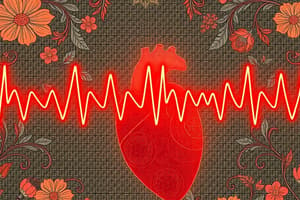Podcast
Questions and Answers
What is a significant risk of taking NSAIDS with anticoagulants or DOACs?
What is a significant risk of taking NSAIDS with anticoagulants or DOACs?
- Increased potassium levels
- Significant risk of bleeding (correct)
- Orthostatic hypotension
- Bradycardia
What is the normal range for aPTT?
What is the normal range for aPTT?
- 50-60 seconds
- 40-50 seconds
- 25-35 seconds (correct)
- 30-40 seconds
When should a client increase their potassium intake while on digoxin?
When should a client increase their potassium intake while on digoxin?
- Always
- When experiencing orthostatic hypotension
- Never
- When concurrently taking diuretics (correct)
What medications are prescribed to reduce the ventricular rate, improve cardiac output, and convert atrial fibrillation to sinus rhythm?
What medications are prescribed to reduce the ventricular rate, improve cardiac output, and convert atrial fibrillation to sinus rhythm?
What medications are associated with orthostatic hypotension?
What medications are associated with orthostatic hypotension?
What symptom requires immediate follow-up after administering nitroglycerin?
What symptom requires immediate follow-up after administering nitroglycerin?
What symptoms should a patient on a corticosteroid report immediately?
What symptoms should a patient on a corticosteroid report immediately?
Why should adenosine be administered in 1-2 seconds?
Why should adenosine be administered in 1-2 seconds?
Flashcards are hidden until you start studying
Study Notes
Anticoagulants and Antiarrhythmics
- A client taking anticoagulants or DOACs like apixaban should avoid taking NSAIDs due to a significant risk of bleeding.
- Digoxin does not require clients to increase their potassium intake, but this may be necessary when concurrently taking diuretics.
- Calcium channel blockers (Diltiazem), beta blockers (metoprolol), and Digoxin are prescribed to reduce the ventricular rate, improve cardiac output, and convert atrial fibrillation to sinus rhythm.
Medication Contraindications
- Beta blockers (metoprolol), non-dihydropyridine calcium channel blockers (diltiazem, verapamil), and all beta blockers (metoprolol, timolol, atenolol) are contraindicated for patients with bradycardia.
- Medications associated with orthostatic hypotension include beta blockers (metoprolol), alpha blockers (terazosin), antipsychotics, antidepressants, diuretics, vasodilators (nitroglycerine, hydralazine), and narcotics (morphine).
Cardiovascular Medications
- A patient should call emergency medical services if their symptoms persist after taking the first dose of nitroglycerin, and then take up to 2 additional doses if pain persists.
- The normal range for aPTT is 25-35 seconds, and on heparin, aPTT should be 1.5-2 times normal value (46-70 seconds).
- Elevated aPTT puts the client at risk for bleeding, while low aPTT puts the client at risk for blood clot formation.
Administration and Follow-up
- Adenosine should be administered in 1-2 seconds due to its half-life.
- The nurse would not need to follow up with a healthcare provider for 10 units NPH insulin IV push.
- Ace inhibitors and ARBs lead to hyperkalemia by reducing aldosterone production, causing potassium retention.
Symptom Management
- After administering nitroglycerin, headache requires immediate follow-up.
- A patient on a corticosteroid should report immediately if they experience symptoms such as personality changes, abdominal pain, or decreased urination.
- During an asthma attack, the nurse would anticipate medications such as beta2 agonists (salbutamol) and corticosteroids.
Studying That Suits You
Use AI to generate personalized quizzes and flashcards to suit your learning preferences.




